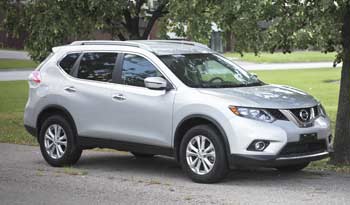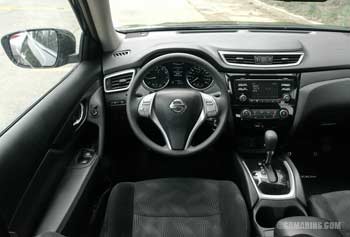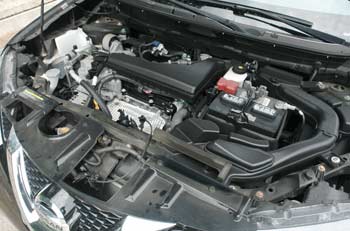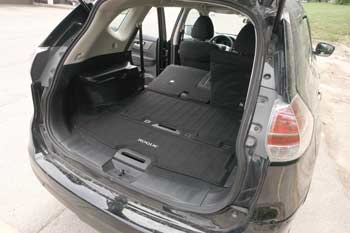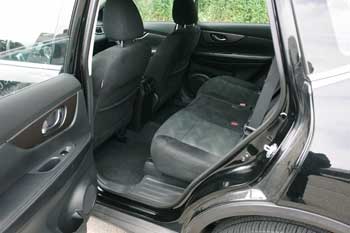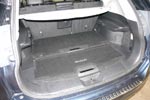Nissan Rogue 2014-2020: pros and cons, problems
By Vlad Samarin. Updated: February 18, 2024
The Rogue is a comfortable stylish mid-size SUV. It has a bulletproof 4-cylinder engine, and comes with front- or all-wheel drive.The Rogue is a pleasure to drive. The interior is nicely finished and well equipped. Third-row seating is available as an option. It's good on gas and doesn't require a lot of maintenance.
Is it a good choice to buy used? What are the common problems? We'll start with pros and cons:
Pros:
- Bulletproof engine.
- Good fuel economy.
- Stylish, sporty looks.
- Spacious, nicely finished interior.
- Tall seating position, good front visibility.
- Pleasant driving experience, comfortable quiet, ride.
- Inexpensive to maintain, easy to work on DIY
- The long-term reliability of the CVT transmission is questionable and it will be expensive to replace if it fails.
- Depreciates faster than other top-selling SUVs.
- Models with third-row seating don't have a spare tire and come with expensive run-flat tires.
- Small towing capacity
In the 2017-2018 Rogue, there was a high number of complaints under 'Forward Collision Avoidance' and 'Service Brakes'. A number of owners mentioned the issue where "the brakes activate automatically for no apparent reason."
The 2019-2020 Rogue received significantly less complaints.
Other problems include air conditioner issues, failing tire pressure sensors, bad wheel bearings, inoperative blower motors, sticking brake calipers and minor Check Engine light issues.
Here are a few examples of reported problems:
One of the possible causes of this problem is icing up of the A/C evaporator. That part is located inside the dash. When the ice builds up, it restricts the airflow from the vents. Once the A/C is turned off and the ice melts, the A/C starts working again.
In general, icing of the A/C evaporator is often caused by issues with the evaporator temperature sensor or its placement. Some owners said changing the evaporator temperature sensor fixed the problem in their Rogue.
According to the bulletin NTB15-062, to repair a popping noise from the front coil springs when turning, both front coil springs and strut bearings need to be replaced. The noise (clunking/popping) could be noticeable when turning the steering wheel all the way from left to right when the car is stopped. Out of warranty, this repair may cost 1.8-2.0 hours of labor per strut plus the parts. We recommend using OEM parts.
The service bulletin NTB20-090a describes two problems: the blower motor being noisy and water dripping on the driver side carpet after going through a car wash. As per TSB, if the blower motor is noisy, it will need to be removed and all foreign debris cleaned. If water is dripping on the driver's side carpet, the debris must be cleaned out from under the cowl area and the cover-air intake installed. If the blower motor is damaged, it will need to be replaced (1.5-1.7 hours of labor plus the part).
A sticking variable timing control solenoid can cause the Check Engine light to come on, intermittent rough idle, stalling, hesitation and codes P0011 or P0014 and P0300. The oil level and condition must be checked first. Often, the solenoid is sticking due to carbon deposits (sludge).
There are three solenoids located in the valve timing control cover on the passenger side of the engine near the top engine mount. According to the service manual, the P0011 could point to the intake valve control solenoid, while the code P0014 could potentially be caused by a problem with the exhaust valve control solenoid. Further diagnostic will be needed to confirm the cause. This video explains the problem well. The part (solenoid) is not expensive, but it takes a couple of hours of labor to replace it.
Several owners have mentioned issues with the CVT transmission. One of the issues is that the vehicle fails to accelerate after driving for some time. This could be caused by overheating of the CVT transmission fluid.
The issue with the CVTs is that they are expensive to replace (over $4,000 with a new part, up to $3,500 with a used part)). We found several informative Youtube videos about extending the life of the CVT transmission. The mechanic working at a Nissan dealership we spoke to advised changing the CVT fluid more often using the OEM Nissan CVT Fluid and making sure to have the fluid at the proper level.
We have found several complaints about navigation, Bluetooth and audio system issues. There are a few reports that some of the problems are fixed after a firmware update. The service bulletin NTB15-011D dated Sept. 27, 2021 for the 2014-2015 Nissan Rogue lists a number of possible problems including the center display screen intermittently going blank, continuous rebooting, freezing and several other issues with the audio system. The TSB advises updating the navigation system software. The bulletin doesn't mention warranty, which means the dealer might charge you for the update if the vehicle is out of warranty.
Advertisement
There have been complaints about sunvisors that won't stay in place and need to be replaced. The repair is not expensive.
Nissan issued the recall for the fuel pump (NHTSA# 15V-197) and several other recalls for the Rogue, check at the NHTSA website.
Summary
The Rogue is a comfortable spacious SUV with some good features and a bulletproof engine. With rear seats folded, it offers 70 cu. ft. of cargo space. As of February 2024, Consumer Reports rates the 2014, 2018 and 2020 Rogue as 'average' for the reliability; other model years of this generation were rated 'below average'.Our main concern is the CVT transmission even though the number of CVT complaints is smaller than for other Nissan models (i.e. 2013 Altima). If you are buying a used Nissan Rogue, we recommend getting an extended warranty for the powertrain (engine and transmission) with no limit per claim. Replacing the CVT transmission is expensive.
The CVT transmission is also less suitable for towing or heavy loads and can overheat after extended driving that can result in reduced power.
Consider the Mazda CX-5, Toyota RAV4 and Honda CR-V as alternative choices.
Features to avoid: We would recommend avoiding models with the sunroof and power liftgate, as these parts could be very expensive to repair when out of warranty.
Related reviews:
Subaru Forester 2009-2013
Ford Escape 2013-2019
Toyota RAV4 2006-2012
Toyota RAV4 2013-2018
Honda CR-V 2012-2016
Mazda CX-5 2013-2016
Jeep Cherokee 2014-2020
What to watch out for when buying a used Nissan Rogue: Since some of the problems mentioned above become evident after driving for some time, it will help if you can test drive the vehicle for as long as possible to get a good feel. Watch out for various mechanical noises (whining, humming) when accelerating or driving on the highway. If in doubt, test drive another Rogue to compare.
The transmission should behave smoothly in all situations. Jerking, hesitation or occasional lack of power are the signs that the vehicle should be avoided. Test the heater and the air conditioner. Check if the sunvisors are not loose. Check if the sunroof opens and closes easily without jamming. Check for corrosion on the roof rails, many owners mentioned this issue. If the vehicle has a power liftgate, test if it works properly.
Nissan Rogue Engine: The Rogue is powered by a 170-horsepower 2.5-liter DOHC 24-valve 4-cylinder QR25DE motor. It has been used in many Nissan vehicles for more than a decade. It's a simple and reliable engine with a conventional multi-port electronic fuel injection. With regular maintenance, this engine can easily last for over 200K.
Engine oil capacity (with filter) is listed at 5-1/8 qt (4.6 liters).
Timing belt or chain: The 2.5L QR25DE engine comes with a timing chain. The timing chain only needs to be replaced if it's stretched or if there are other issues with it. There is no timing belt.
Nissan Rogue Fuel Economy: Nissan Rogue is one of the most fuel-efficient SUVs. The 2015-2016 front-wheel drive Rogue is rated at 26/32 mpg. The all-wheel drive model is not far behind at 25/31 mpg; see fuel consumption data in the table. The 2016 AWD Rogue can travel up to 435 miles (700 km) on one tank of gas on a long highway trip.
| Nissan Rogue EPA Fuel Economy: |
mpg city/hwy |
L/100 km city/hwy |
| 2017-2019 Rogue Hybrid FWD | 33/35 | 7.1/6.7 |
| 2017-2019 Rogue Hybrid AWD | 31/34 | 7.6/6.9 |
| 2017-2020 Rogue FWD | 26/33 | 9.0/7.1 |
| 2015-2016 Rogue FWD | 26/32 | 9.0/7.4 |
| 2014 Rogue FWD | 25/32 | 9.4/7.4 |
| 2017-2020 Rogue AWD | 25/32 | 9.4/7.4 |
| 2014-2016 Rogue AWD | 25/31 | 9.4/7.6 |
Nissan Rogue Photos:
Lineup: The US lineup includes the base S, mid-level SV and top SL trim levels. The more common Rogue S and SV come with 17" wheels. The SL comes with leather seats, a premium Bose audio system and 18" rims. Third-row seating is only available in S and SV trims. The Around View Monitor is standard in SL and is available in SV as a part of the Premium Package.
Mechanical: The Rogue has MacPherson struts in the front suspension. The rear suspension uses an independent multi-link layout. All four wheels have vented disc brakes. Anti-lock Brake System and Stability Control are standard.
Nissan Rogue AWD System: The Rogue offers a simple optional all-wheel drive system. The front wheels are powered at all times and the rear axle engages when needed. How it works: a small transfer assembly is attached to the transmission and sends the torque to the rear axle via a propeller shaft. The amount of torque sent to the rear wheels is controlled by an electrical coupling installed in the rear differential. This system is similar to what many modern SUVs have and is tuned for better fuel economy rather than off-road performance.
Crash test scores: The NHTSA rates the 2014-2018 Nissan Rogue with 4 stars overall. See details in the table.
| Overall rating | Frontal crash | Side crash | Rollover | |
| 2014 Rogue | ||||
| 2015 Rogue | ||||
| 2016 Rogue | ||||
| 2017 Rogue non-hybrid | ||||
| 2018 Rogue non-hybrid |
